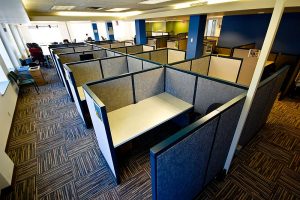From cottage industry to cubicles to open offices and back home to “flatten the curve,” COVID-19 has brought some work full circle.
Ever since the widespread adoption of agriculture transformed what we’d now call hobbies (like hunting, fishing and gardening) from play into toil, workers have been subject to changing fads. Office workers have been cubicled, hotdesked, subject to the noise and intrusion of open offices, and now many are working from home, perhaps long beyond the day it becomes safe to return. Has COVID changed office work for good?
Offices are thought to have originated in ancient Rome as a place to conduct official business, but dedicated office buildings only came about in the 1700s. The first was built in London in 1726, to handle the increasing complex administration needs of the Royal Navy. The East India Trading Company followed closely behind, building its headquarters in 1729. Soon, the concept of using a centralized space to handle mountains of paperwork became a lasting trend, and professionals such as lawyers and civil servants moved their work from home into the new office buildings.
From the beginning, there was a line drawn between “intellectual work” and “mechanical work.” A UK government report on office design insisted that separate rooms were necessary for continuous, uninterrupted mental tasks, while more open offices were ideal for supervising collaborative efforts. The executive’s private space mirrors the reflective solitude of a monk’s cell, while factories surely inspired open offices, where workers move information and paperwork around instead of manufactured goods.

By the 1950s, lower ranking office workers labored at rows of desks in large, open rooms. In the 1960s, designer Robert Propst, research leader for furniture manufacturer Herman Miller, noticed that executives with offices tended to be more productive than worker bees who were immersed in the sound of telephones ringing, typewriters clacking away, and back then, the smell of cigarette smoke. In response, Propst designed the Action Office, a customizable suite of lightweight, adjustable desks and acoustic panels to muffle office noise. Action Offices flopped, but Propst evolved his design. The acoustic panels became modular walls of varying heights, simple to assemble and widely customizable. Office managers paid attention this time, but to his lasting dismay, they dropped the individuality and used Propst’s design to create rows of small identical boxes to fit more workers into the same space: the cubicle farm.
Propst’s intent was to enable worker creativity and individuality, but cubicles soon became associated with soul-sucking corporate conformity. In the late 1990s, those modest walls started coming down again, ostensibly to promote collaboration between workers, but the lack of privacy meant easier surveillance for managers, too. A new generation of office managers, who no longer remembered the noise and distractions of the 1950s open offices, were now making the decisions. In 2017, an estimated 68% of American offices had minimal or no barriers between workers. Both productivity and collaboration suffered. Workers wore AirPods or noise-cancelling headphones to regain a modicum of privacy that they lost to the resurgent trend toward open offices.
Then COVID-19 arrived. One day, workers were came to the office, the next day, many found themselves telecommuting. CDC recommendations for reopening offices include keeping workstations six feet apart or installing plastic desk shields, temperature checks, improving ventilation, removing seating in common areas, and discouraging carpooling. The pendulum would have to swing from open offices back to cubicles. Employers may find that once the cost of these adjustments are added to the reduced costs of renting office space, paying for utilities and janitorial services, and reducing the chance of unionization, it may simply be cheaper to keep employees at home. According to one survey, 86% of remote workers feel more productive, and 76% wanted to continue working from home for at least half of their week. Companies like Amazon, Microsoft, Twitter and Zillow are allowing some employees to work from home indefinitely.
Thus, we are coming full circle. The modern-day equivalents of those lawyers and civil servants who moved into the world’s first office buildings are moving home again.
Related: Hate Mondays? Your Job Might Be To Blame
Sources:
How has humans’ relationship with work changed over millennia?
Hate your cubicle? Thank medieval monks
Why the Inventor of the Cubicle Came to Despise His Own Creation
Workers Love AirPods Because Employers Stole Their Walls
C.D.C. Recommends Sweeping Changes to American Offices
The return of the cubicle? Companies rethink office life post lockdown


Join the conversation!